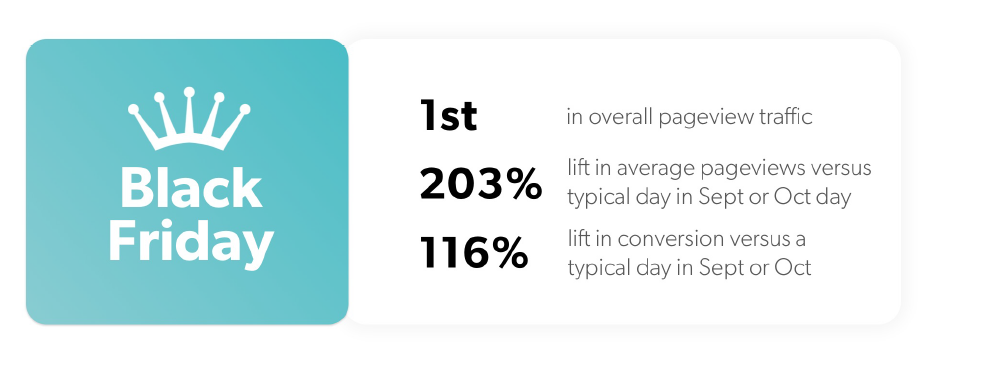
Labor Day was just two weeks ago, and the last day of summer, September 23rd, has not yet passed. Despite this, the entire retail industry has been gearing up for the biggest, and most wonderful, time of the year: the holiday season.
Last year, the National Retail Federation reported a $691.1 billion total consumer spend during the holidays, up 5.5% increase from 2016. Online spending grew at an even faster rate, with a 11.5% year-over-year increase. If history holds, the 2018 holiday season will be another record-breaking year for shopping.
With big opportunity, comes big risk. It is critical for brands and retailers to take advantage of this surge in shopping and to meet and exceed their sales goals during the winter season. To do this, brands, retailers, and agencies must understand how consumers prefer to shop, what motivates them to buy, and what retail and marketing experiences appeal to them during the busiest shopping season of the year.
To understand consumer behavior at the holidays and what trends might be emerging to shape the upcoming season, we partnered with Wakefield Research to survey 2,500 U.S. adults to learn more about their holiday shopping expectations and preferences.
To complement the survey, we analyzed holiday shopping data across our network of more than 6,000 brand and retailer websites. We examined purchase paths, research behaviors, and shopping patterns across different product categories and time frames to gain further insight into when people shop for what and for how long.
Based on this research, these are the eight biggest holiday shopping trends impacting the retail industry during the upcoming season.

1. Black Friday dominates the holiday shopping season.
Despite the fact that holiday shopping and sales start earlier and earlier each year, Black Friday continues to be the biggest shopping day of the season, coming in as the most popular shopping day for nearly every product category we studied. Last year, our Network of 6,000+ brand and retailer websites saw a record-breaking $1.3 billion in sales on Black Friday, and online traffic was the highest of the season, accounting for a 203% lift in average traffic and a 116% lift in conversion. Consumers confirm the popularity of Black Friday too: more than half of shoppers surveyed named it as their primary holiday shopping day.
Tip: Black Friday falls earlier than usual this year on November 23rd. Before starting any advertising and marketing campaigns, make sure your product pages are in good shape with completed information, high-quality photos, and fresh consumer-generated content (ratings, reviews, photos, and videos from previous customers). Consumers will be doing their due diligence in the weeks leading up to Thanksgiving weekend by researching products and checking prices, so make sure the information they need to inform their purchase decisions is available.

2. Thanksgiving Day is giving Cyber Monday a run for its money.
For the first time, our Network saw higher purchases and revenue on Thanksgiving Day than on Cyber Monday. Thanksgiving Day brought in $1.2 billion in sales, while Cyber Monday accounted for $912 million, down noticeably from $1.3B in 2016. Furthermore, Thanksgiving was the highest day for mobile sales at $624 million and had the highest average order value, even beating out Black Friday with these numbers.
Tip: If you sell products online, make sure the shopping experience is as easy and straightforward as possible. On Thanksgiving Day, consumers are likely shopping online from home, in between time with family and friends, so they don’t want to spend a lot of time and effort making purchases. Consider serving up personalized product recommendations and integrating your social media with your e-commerce experience; both tactics make the path to purchase shorter and more direct for consumers.
3. Mobile shopping will continue to set records this holiday season.
Last year, mobile accounted for more than half of the online traffic to most product categories. During the five-day Thanksgiving weekend shopping spree, mobile accounted for 55% of all pageviews and 44% of all revenue. Traffic from mobile peaked on Christmas Day, with a second, smaller spike the day after, particularly in the holiday decor category.
Tip: Around big holidays like Thanksgiving and Christmas, many consumers use their phone or tablet to shop online from the comforts of their couch. In addition, many shoppers are using their phones in-store to compare prices, check item availability, and read customer reviews. To capitalize, make sure your website and marketing and advertising campaigns are optimized for mobile and that your brand is active on social media throughout major holidays.

4. Toys and games continue to be popular gifts, but they’re not just for little kids.
Toys will probably always top holiday wish lists. Last year, of the twenty product categories we looked at, the toys category saw the highest conversion lift with a 605% increase during the holiday season. However, teens and adults can play with toys too — video game consoles had the second highest conversion lift at 461%. Black Friday was the biggest online traffic day for both, with toy traffic at 4.1X and video game console traffic at 7.8X higher than usual. Both categories also see steady traffic leading up to December 25th, meaning that the entire month of December is an important time for toy shopping of any kind.
Tip: It is critical to target your customers based on their shopping intent, not just traditional demographic information like their age, gender, or location. Many different types of people will be shopping for toys and games during the holidays. A woman without children may still be purchasing toys, whether Legos for a niece, a Nintendo Switch for her boyfriend, or a donation to a toy drive. If someone is perusing retailer websites looking at different video game console systems, reading customer reviews, and leaving a Nintendo Switch in their shopping cart, this is the type of person you want to target with a video game-related advertising campaign.
5. Some consumers have a plan of attack for their holiday shopping, while others go off impulse.
When it comes to the holidays, there are two types of consumers: the planners and the spontaneous shoppers. In our survey, 59% of respondents categorized themselves as a “prepared shopper,” meaning they plan out the gifts they want to buy in advance. This group starts making their shopping lists, looking for sales, and stocking up on gifts and supplies an average of 42 days ahead of the holidays. Of note, one in four shoppers gets a head start of two months or more, meaning holiday shopping season will soon begin.
On the other side of the spectrum, 42% of those surveyed said they do not plan what they are going to buy ahead of time and prefer to browse and buy as they go, with 34% reporting that they do not make a gift list in advance. Across both groups, impulse buying is common: 57% said they are more likely to shop impulsively during the holidays compared to the other times of the year.
Tip: Plan for both types of holiday shoppers. For example, for the planners, incorporate wish list functionality into your website, so they can save items they plan to buy, and deploy early bird advertising campaigns well in advance of the holidays. For the spontaneous shoppers, display an assortment of stocking stuffers and last-minute items close to the point of purchase, whether it’s near the checkout line in your physical stores or via product galleries and carousels on your website. To capture this group through advertising, focus campaigns around the dates of major shopping spikes for your category.
6. In addition to physical gifts, consumers are gifting experiences.
While the majority of shoppers plan to give physical gifts to their loved ones this year, nearly one in three plans to give meaningful experiences as gifts. Craft-related gift experiences were the most popular (47%), followed by food-related (45%) and travel-related (41%) experiences. Perhaps related to the travel-related experiences, the luggage category saw a 133% conversion lift during the holiday season compared to typical, with spikes around Thanksgiving week and the first two weekends of December.
Tip: Take note of this growing trend and target promotions and campaigns around this emerging, non-traditional category. Millennials in particular would likely respond well to these campaigns, as almost half indicated that they plan to purchase experiential gifts during the holidays.
7. Shoppers find gift inspiration everywhere.
There is no one singular way that consumers find inspiration for gifts. When searching for gift ideas for others, 61% of consumers are inspired while browsing online or shopping in store, 54% by recommendations from friends and family, 43% by advertising, 30% by product recommendations based on past purchases, and 27% by social media platforms like Instagram and Pinterest. The wide variety of channels speaks to the many ways consumers get gift ideas during the holidays.
Tip: To reach shoppers wherever they are, you must have an omnichannel strategy in place. Every touchpoint with a consumer is an opportunity to provide inspiration. Since recommendations from friends and family are a top source, see how you can incorporate influential customer reviews across your marketing mix, like incorporating them into word-of-mouth online ads and highlighting them on social media.

8. Don’t underestimate the power of the holiday spirit.
According to our survey, consumers associate shopping during the winter season as an integral part of getting into a festive holiday spirit. Of holiday shoppers who brave the crowds and shop in-store, 42% of them said they do it to enjoy the festive ambiance, and 32% consider special holiday activities, such as visiting Santa or ice skating, important to the in-store shopping experience. In regards to Thanksgiving weekend, 35% shop on these sales days to get into the holiday spirit, and 25% say shopping on sales days is a family tradition.
Tip: Whether online or in-store, delivering a positive shopping experience is always important. During the holidays, it is even more critical. In-store, incorporate festive decor and activities that not only attract shoppers but also entertain them. If your advertising campaign is driving in store, measure the impact of your holiday ad spend with an offline attribution partner. Online, an efficient shopping experience should be the priority, but consider how you can spread holiday spirit — curate a holiday-themed playlist that consumers can download, showcase inspiring gift guides, or allow shoppers to celebrate the season of giving by donating to a charity at checkout.
The holiday season is upon us. Brands, retailers, and their marketing and advertising partners must be ready for the influx of shopping. To unwrap more holiday shopping trends, follow along with our holiday blog series and visit our Holiday Headquarters.



